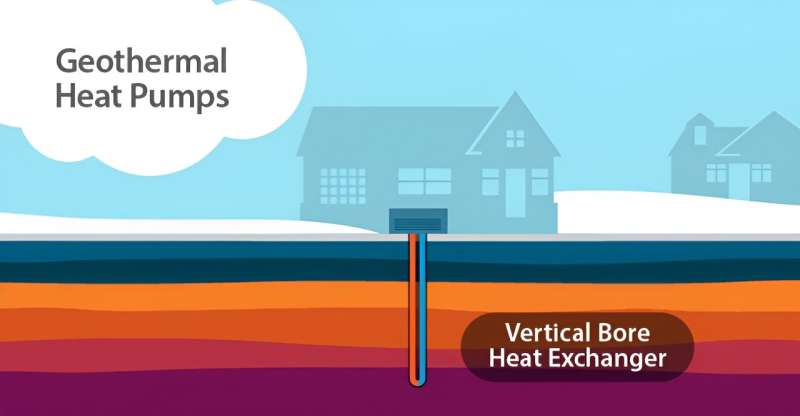This article has been reviewed according to Science X's editorial process and policies. Editors have highlighted the following attributes while ensuring the content's credibility:
fact-checked
trusted source
proofread
Researchers enhance energy optimization web tool with hybrid geothermal heat exchange technology

The National Renewable Energy Laboratory (NREL) has added a new capability to the REopt web tool to help commercial building owners and energy managers more effectively evaluate the costs associated with geothermal heat pump (GHP) projects: the ability to integrate hybrid heat exchange with GHPs.
The publicly available REopt web tool is a techno-economic decision support platform used to optimize energy systems for buildings, campuses, and microgrids. REopt identifies the optimal mix of renewable energy, conventional generation, energy storage, and now GHP technologies to meet cost savings, clean energy, and resilience goals.
GHP retrofits often require renovation to a facility's heating and cooling systems. While retrofits can improve heating and cooling efficiency and reduce associated carbon emissions, justifying GHP retrofits based on building economics alone is sometimes challenging. NREL researchers have added another GHP configuration option to REopt to help analysts identify cost-effective solutions. Hybrid geothermal heat exchange (GHX) technology integrates GHP systems with auxiliary heat exchange units, allowing facility owners and managers to reduce GHX system capital costs while improving the overall economics of GHP projects.
"More options present more opportunity to discover greater benefits and economic viability. Hybrid geothermal heat exchange systems include a supplemental device connected to the ground loop, either a cooling tower or small boiler, that can reduce the size, and therefore costs of the GHX. It's a configuration option that REopt users can examine when considering the costs and benefits of a GHP retrofit," says Dan Olis, NREL mechanical engineer.
To demonstrate the potential benefits of hybrid GHX, NREL conducted a case study using the REopt web tool. The study compared a non-hybrid GHP system to a hybrid GHX system in a large office building in Las Vegas, Nevada, with a total area of 498,588 square feet. The analysis considered electricity costs of $0.10/kWh energy charges plus $10/kW monthly demand charges and natural gas costs of $10/MMBtu.
The study results revealed significant cost savings and improved performance with the hybrid GHX system. The non-hybrid GHX system required 310 boreholes, each 400 feet deep, while the hybrid GHX system needed 56 boreholes plus an auxiliary cooling tower with a capacity of 245 tons.
In terms of costs, the capital expenditure for the non-hybrid GHX system amounted to $3.18 million before incentives ($1.63 million after accounting for federal tax incentives), whereas the hybrid GHX system's capital expenditure was $1.88 million ($0.96 million after incentives). The net present value of the hybrid-GHX system amounted to $3.09 million, surpassing the net present value of the non-hybrid system by $460,000. When looking at the net energy savings and reduced capital costs, REopt determined the hybrid GHX system was a more cost-effective option in this scenario.
Now any REopt user can compare GHP and hybrid GHX systems in this way, using basic information like system size, intended use, and current energy costs to identify optimally sized heating and cooling solutions.
GHPs and the hybrid GHX capability features build on the existing REopt model. NREL partnered with Thermal Energy Systems Specialists Inc., leveraging their GHX model and its hybrid capability to open possibilities for alternative GHP configurations as the REopt web tool continues to evolve. By identifying cost-effective systems that align with users' energy goals, REopt helps contribute to a more sustainable future.

















